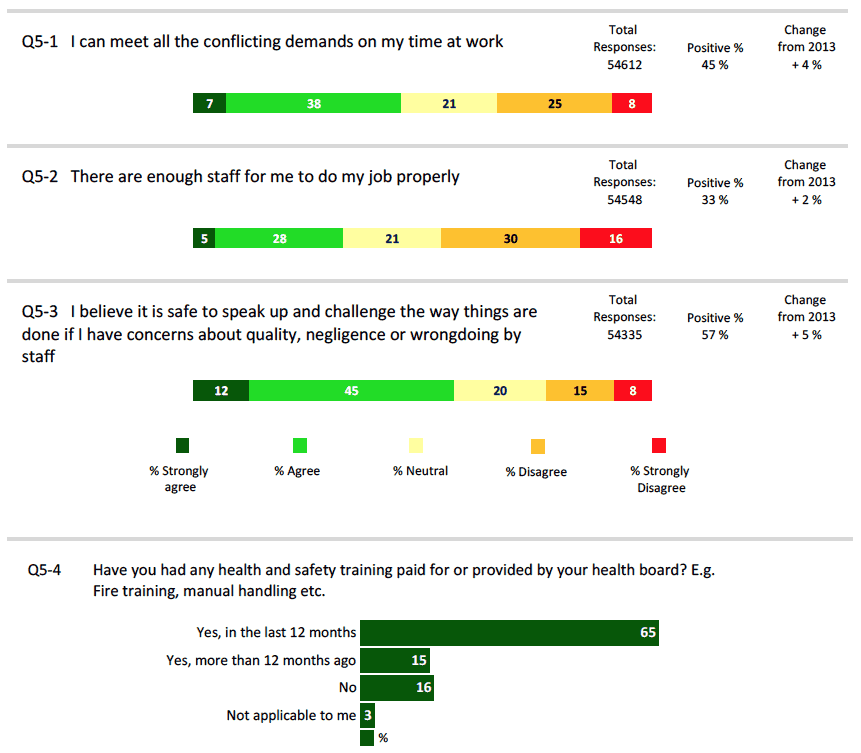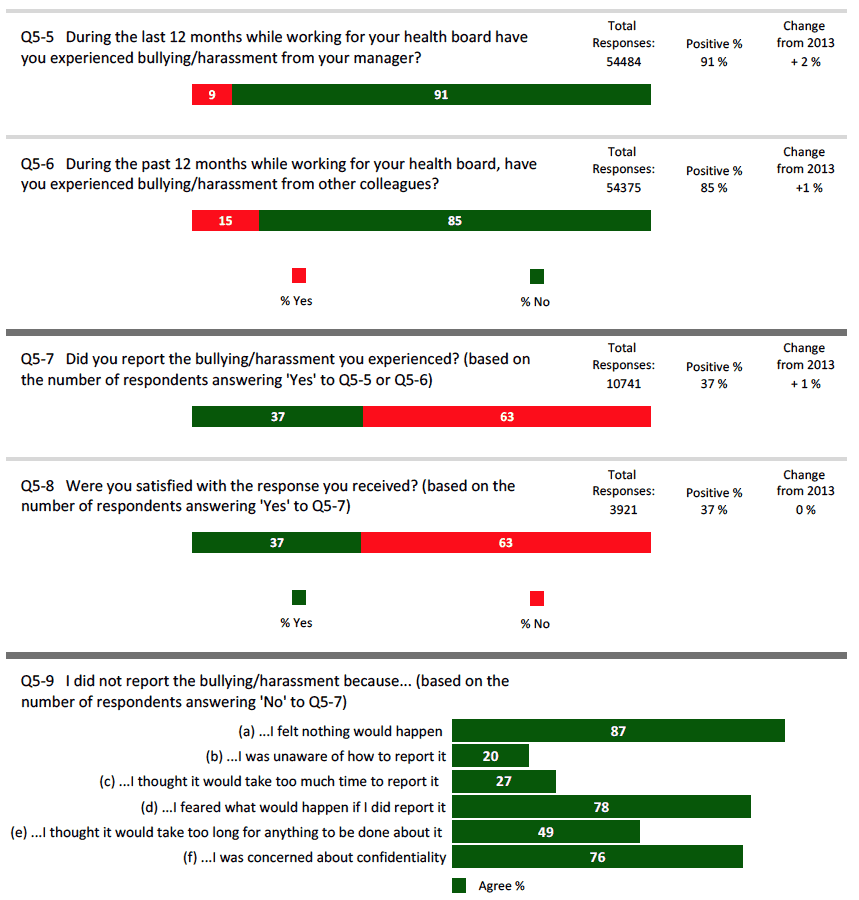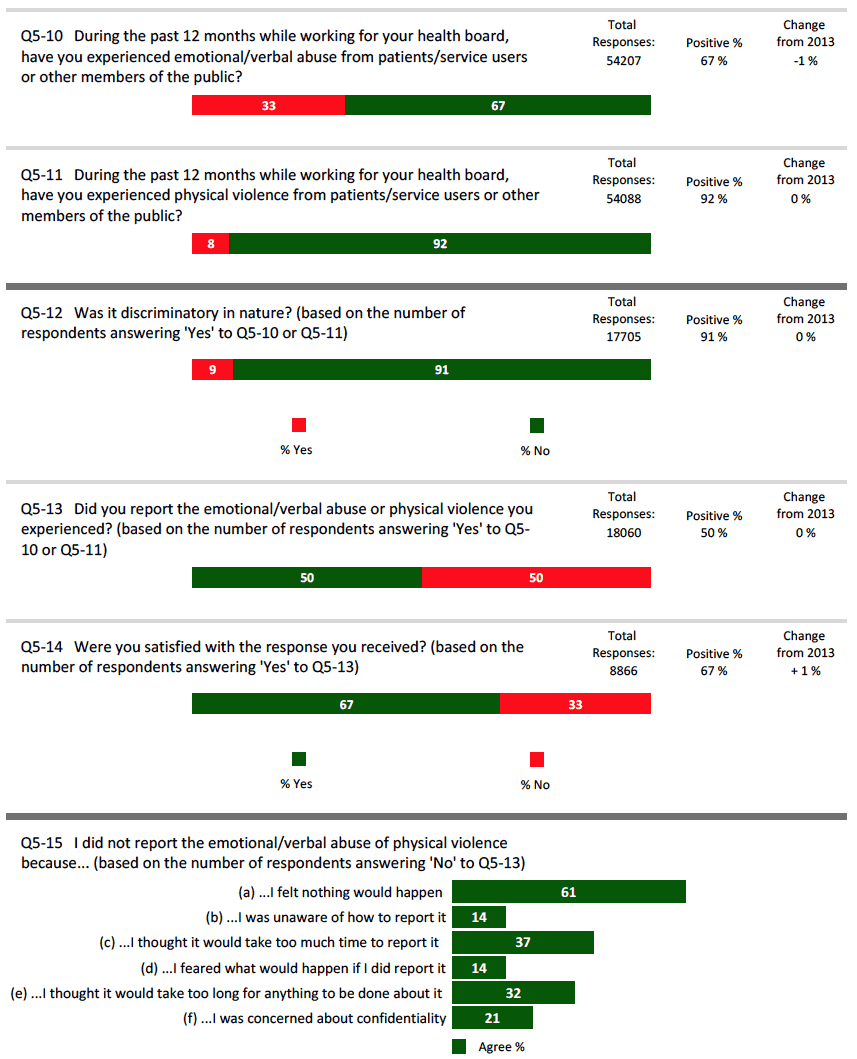NHSSCOTLAND STAFF SURVEY 2014 National Report
This National Report provides an overview of the results of the 2014 NHSScotland Staff Survey. The National Staff Survey gives all NHSScotland staff the opportunity to provide feedback on their experience of working for the organisation.
11 Provided with a continuously improving and safe working environment promoting health and wellbeing of staff, patients and the wider community
All staff should be provided with a safe working environment. Employers have a duty (and a legal requirement) to protect the health, safety and welfare of their employees in the workplace. The fifth element of the NHS Staff Governance Standard states that staff are to be 'Provided with a continuously improving and safe working environment, promoting the health and wellbeing of staff, patients and the wider community'. In this section of the survey, staff were asked for their views in relation to the above.
Figure 9 shows that all three statements within this Staff Governance Standard had an improvement in percentage of positive responses in 2014 compared to 2013.
- Q5-3 I believe it is safe to speak up and challenge the way things are done if I have concerns about quality, negligence or wrongdoing by staff (57% positive responses )
- Q5-1 I can meet all the conflicting demands on my time at work (45%)
- Q5-2 There are enough staff for me to do my job properly (33%).
Across NHS Boards, there was a range in the percentage of positive responses for these three questions (see details in Appendix C). Executive Grades/Senior Managers who responded to the survey were the most likely to agree 'I believe it is safe to speak up and challenge the way things are done if I have concerns about quality, negligence or wrongdoing by staff' (79%) and Ambulance staff who responded to the survey the least likely to do so (35%). Salaried General Practitioners who responded to the survey were the most likely to agree 'There are enough staff for me to do my job properly' (48%), whilst Ambulance staff were the least likely to agree (19%). Administrative and Clerical staff (60%) were the most likely to agree that they can meet all the conflicting demands on their time at work', whilst Medical/Dental staff were least likely to agree (32%) - see details in Appendix D.
Figure 9 also shows that eight out of ten staff (80%) who responded to the survey said they had received health and safety training paid for or provided by their NHS Board. Across NHS Boards, this ranged from 44% to 91% (see details in Appendix C). Allied Health Professionals (92%) were the most likely to have undertaken such training and Ambulance staff the least likely to have done so (46%), see Appendix D.
In summary, all three statements in this strand showed an increase in positive responses between 2013 and 2014. Eight out of ten staff who responded to the survey had undertaken health and safety training that was paid for or provided by their Board: this was lower than in 2013.
Figure 9 ‐ Provided with a Continuously Improving and Safe Working Environment Promoting the Health and Wellbeing of Staff, Patients and the Wider Community

[Note: The sum of the total responses throughout this report may not be exactly equal to 100% due to rounding.]
11.1 Bullying/harassment
In the survey, staff were asked if they had experienced bullying/harassment in the past 12 months from their manager or from other colleagues. Figure 10 shows that, 9% of staff (down from 11% in 2013) who responded to the survey said that they had experienced bullying/harassment from their manager (Q5-5) and 15% of respondents said that they had experienced bullying/harassment from other colleagues (Q5-6).
The percentage of respondents who had experienced bullying/harassment from their manager or from other colleagues in the past 12 months varied across NHS Boards: between 5% and 20% for the former and between 8% and 24% for the latter (see Appendix C for more details).
Ambulance staff who responded to the survey were the most likely to say that they had experienced bullying/ harassment from their manager (16%). Doctors in Training and Salaried GPs were the least likely to do so (3%). Ambulance staff who responded to the survey were the most likely to say that they had experienced this from other colleagues (23%), whilst the least likely to do so (8%) were Salaried General Practitioners (see Appendix D for more details).
Of those respondents who said that they had experienced bullying/harassment, 37% said they had reported it (Q5-7). Across NHS Boards, the level of reporting ranged from 26% to 44% (see Appendix C for more details). The most commonly identified reasons for non-reporting were:
- I felt nothing would happen (87%)
- I feared what would happen if I did report it (78%)
- I was concerned about confidentiality (76%).
Fewer than two in five respondents (37%) who reported the bullying/harassment they experienced were satisfied with the response they received.
In summary, of the staff responding to the survey, 8% reported that they had experienced bullying/harassment in the past 12 months from their manager and 15% from other colleagues. The level of reporting of bullying/harassment increased slightly in 2014, although remained below 40%. Of those who did report the bullying/harassment they experienced, fewer than 40% were satisfied with the response they received. The most commonly identified reasons for not reporting the bullying/harassment were because respondents felt that nothing would happen, they feared what would happen if they did report it and/or they had concerns about confidentiality.
Figure 10 ‐ Provided with a Continuously Improving and Safe Working Environment Promoting the Health and Wellbeing of Staff, Patients and the Wider Community

[Note: The sum of the total responses throughout this report may not be exactly equal to 100% due to rounding.]
11.2 Emotional/verbal abuse and physical violence
In the survey, staff were asked if they had experienced emotional/verbal abuse and/or physical violence from patients/service users or other members of the public in the past 12 months. Figure 11 shows that one in three staff (33%) who responded to the survey said that they had experienced 'emotional/verbal abuse' (Q5-10) and 8% had experienced 'physical violence' (Q5-11). Nine per cent of respondents who experienced abuse or violence described it as 'discriminatory' in nature, the same proportion as in 2013.
Of those respondents who said they had experienced abuse or violence, half (50%) had reported it (Q5-13). Two out of three staff (67%) who had reported the abuse/violence were satisfied with the response received (Q5-14).
The most commonly identified reason for non-reporting was that staff felt nothing would happen (61%).
There was variation between NHS Boards, particularly the Special Boards, in the percentage of respondents who said that they had experienced emotional/verbal abuse or physical violence in the past 12 months from patients, service users or other members of the public (see details in Appendix C). The level of reporting also varied widely across Boards.
Ambulance staff who responded to the survey were the most likely to say that they had experienced emotional or verbal abuse from patients/service users or the public in the past 12 months (69%) and Health Promotion staff the least likely to do so (9%). Ambulance staff who responded to the survey were the most likely to say that they had experienced physical violence from patients/service users or the public in the past 12 months (26%), see Appendix D for more details.
In summary, of the staff responding to the survey, 8% reported that they had experienced physical violence in the past 12 months and approximately one third of respondents stated that they had experienced emotional/verbal abuse. Half of those who had experienced abuse/violence had reported it. Two thirds of those who reported the abuse/violence they experienced said that they were satisfied with the response. The most common reason for non-reporting was because respondents felt that nothing would happen if they did report it.
Figure 11 ‐ Provided with a Continuously Improving and Safe Working Environment Promoting the Health and Wellbeing of Staff, Patients and the Wider Community

[Note: The sum of the total responses throughout this report may not be exactly equal to 100% due to rounding.]
Contact
Email: Malcolm Summers
There is a problem
Thanks for your feedback